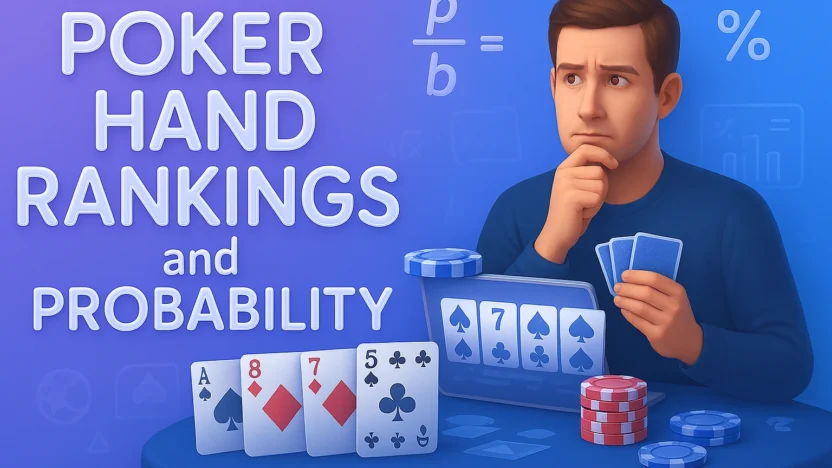Last Updated on November 19, 2025 by Caesar Fikson
Poker only feels mysterious until you map the math. Once you know how hands rank, how often they appear, and how ties actually break, your decisions get sharper fast. I’ll keep this pragmatic: you’ll get crisp ranking tables, real probabilities for both classic 5-card hands and 7-card Hold’em boards, plus a few operator-side notes from we at NOWG so you can read the room like a pro.
Hand rankings at a glance (highest → lowest)
- Royal Flush (A-K-Q-J-10 all same suit)
- Straight Flush (five in sequence, same suit)
- Four of a Kind
- Full House (three of a kind + a pair)
- Flush (five same suit, not sequential)
- Straight (five in sequence, suits mixed)
- Three of a Kind
- Two Pair
- One Pair
- High Card
Tie-breaks in plain English
• Straights: the top card decides (A-2-3-4-5 counts as a 5-high straight; A is low there).
• Flushes: compare highest card, then next, etc. Suits don’t rank.
• Full House: compare the trips rank first, then the pair.
• Two Pair: compare the higher pair, then the lower pair, then the kicker.
• One Pair / Trips / Quads: compare the set first, then kickers in order.
5-card poker probabilities (draw or stud, five dealt cards)
Total 5-card combinations = 2,598,960. Counts exclude “better” versions (e.g., flush excludes straight flush).
5-card hand frequencies
| Hand | Combinations | Probability | Approx. odds |
|---|---|---|---|
| Royal Flush | 4 | 0.000154% | 1 in 649,740 |
| Straight Flush (excl. royal) | 36 | 0.001386% | 1 in 72,193 |
| Four of a Kind | 624 | 0.02401% | 1 in 4,165 |
| Full House | 3,744 | 0.1441% | 1 in 694 |
| Flush (not straight flush) | 5,108 | 0.1965% | 1 in 509 |
| Straight (not straight flush) | 10,200 | 0.3925% | 1 in 255 |
| Three of a Kind | 54,912 | 2.1128% | 1 in 47 |
| Two Pair | 123,552 | 4.7539% | 1 in 21 |
| One Pair | 1,098,240 | 42.2569% | ~1 in 2.37 |
| High Card | 1,302,540 | 50.1177% | ~1 in 2 |
I’m opinionated about this: if you ever see wildly different 5-card numbers, someone mixed in straight-flushes with flushes or counted “permutations” instead of combinations. Use the table above as your sanity check.
7-card (Texas Hold’em) “best hand” probabilities
In Hold’em you see up to 7 cards (2 hole + 5 board). These are the chances that your best 5-card hand will be at least the listed rank by showdown. Total 7-card combinations = 133,784,560.
7-card hand frequencies (final best hand)
| Hand | 7-card combos | Probability | Approx. odds |
|---|---|---|---|
| Royal Flush | 4,324 | 0.00323% | 1 in 30,940 |
| Straight Flush (excl. royal) | 37,260 | 0.0279% | 1 in 3,589 |
| Four of a Kind | 224,848 | 0.1681% | 1 in 595 |
| Full House | 3,473,184 | 2.5961% | 1 in 38 |
| Flush (not straight flush) | 4,047,644 | 3.0255% | 1 in 33 |
| Straight (not straight flush) | 6,180,020 | 4.6194% | 1 in 22 |
| Three of a Kind | 6,461,620 | 4.8298% | 1 in 21 |
| Two Pair | 31,433,400 | 23.4955% | ~1 in 4.26 |
| One Pair | 58,627,800 | 43.8225% | ~1 in 2.28 |
| High Card | 23,294,460 | 17.4119% | ~1 in 5.74 |
Two practical takeaways I drill into new players: 1) Two pair is common in 7-card poker—don’t overvalue weak two-pair on wet boards. 2) “I had a flush draw” isn’t rare; you and your opponents will both make flushes often enough to warrant kicker discipline.
Reading the board like an analyst (quick context you can use)
Board texture matters more than your hand name
A pair is not “a pair.” Top pair with top kicker on a dry board plays very differently from bottom pair on a four-straight board. Knowing the base frequencies above helps you judge how many better combos villain plausibly has.
Suited ≠ flushy (most of the time)
Two suited hole cards look pretty, but a river flush (in 7 cards) still only lands ~6.4% from the flop when you have a nut-flush draw (9 outs, ~35% by river), and far less if you start rainbow. Bet sizing should reflect draw math, not outfit coordination.
Kickers quietly decide stacks
At showdown, so many “close” pots are just kicker wars. Ace-kicker value is real; dominated kickers burn bankrolls. I’ve watched more money lost to bad kickers than to bad bluffs.
Combinatorics without the headache
Why the counts look the way they do (one example):
• Two Pair (5-card): choose the two ranks for pairs C(13,2)=78; choose suits for each pair 6×6; choose kicker rank (11) and suit (4). Multiply: 78×6×6×11×4 = 123,552.
That same logic drives every line in the 5-card table. For 7-card, we count “at least” hands across C(52,7) combos, which is why those probabilities jump.
Common misconceptions (and quick fixes)
• “A flush is rare; I should slow-play it.” In 7-card poker a flush appears ~3% of the time. Strong, yes—board-dependent, absolutely. On paired boards, full houses skyrocket; proceed like an adult.
• “Any straight is huge.” Not on a four-straight board when your straight isn’t the nuts. The top card rule decides; 9-to-K loses to 10-to-A.
• “Suited connectors always print.” They play nicely multi-way, but reverse implied odds are real when you make second-best flushes/straights.
Quick lookup: which hand beats which within classes
Flush vs Flush
Compare highest card; if tied, next highest, and so on (A-Q-9-6-3 beats A-Q-9-6-2). Suits never break ties.
Full House vs Full House
Trips rank first (Q-Q-Q beats J-J-J regardless of the pair); only if trips tie do you compare the paired rank.
Straights: Aces can be low
A-2-3-4-5 is a 5-high straight (the lowest). A-K-Q-J-10 is the highest and is also called “Broadway.” In between, the top card names the hand.
A few “how often” heuristics you’ll actually remember
• 5-card: you’ll see one pair about 42% of the time and “nothing” (high card) about 50%—this is why kickers matter.
• 7-card Hold’em: two pair shows up about 23%, trips about 4.8%, flushes 3%, full houses 2.6%. If the board’s paired and the pot’s big, don’t pretend boats are unicorns.
My table advice you didn’t ask for (but will use)
Pick your fights with math in mind. On scary boards, count how many better 5-card combos your opponent can credibly have (flushes, higher straights, boats). If that set is large and your hand sits in the middle of the range chart above, keep your stack size sensible. This isn’t negativity—it’s discipline. I’ve sat in too many rooms where “but I had a straight” turned into a donation.
If you want me to adapt these tables for your app, pit training, or player education module, we at NOWG can customize by game format and stakes. And if you’re tuning your product mix, promos, or analytics, try NOWG’s free online tools for casinos—bonus liability estimators, churn predictors, and CAC→LTV simulators—to pressure-test decisions before you spend a cent.




